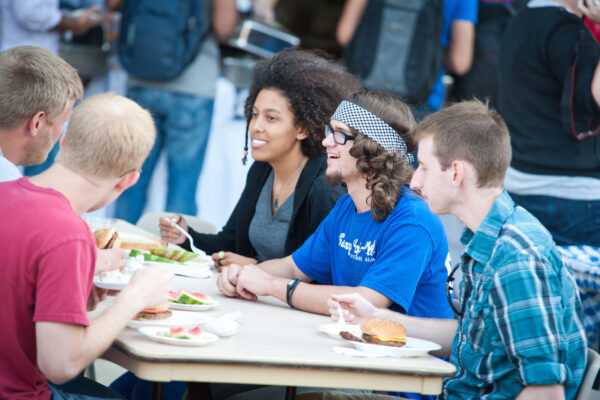This post is the first in a new series, Beyond the Margins: Meeting the Needs of Underserved Students.
Lesbian, gay, bisexual, transgender, and queer (LGBTQ) students are more visible than ever on U.S. college campuses. Yet they remain both sexual-orientation and gender-identity minorities (that is, as a numerical proportion of the student body) and minoritized (that is, targets of discrimination and oppression by those in power). Referring to these students as minoritized on the basis of sexual orientation and gender identity highlights the role of societal heterosexism, which privileges heterosexuals, and cisgenderism, which privileges people whose gender identity aligns as society expects with the sex they were assigned at birth. Although it is common on campus to conflate people with these minoritized identities into one “LGBTQ” group, in reality, sexual orientation and gender identity are different concepts.
In the last decade, LGBTQ people in the United States—particularly in K-12 and higher education—have gained increasing visibility and some civil rights, including open service in the U.S. military, marriage equality, and some state- or local-level protection against bullying and hate crimes. Yet problems remain. There are no federally protected rights to employment non-discrimination, and the application of Title IX protection against discrimination for transgender students is currently under review in the U.S. court system. In higher education, we face a particular challenge in understanding our needs and progress vis-à-vis LGBTQ students because we lack accurate institutional and national data on student sexual orientation and gender identity.
Key issues for higher education leaders
Of the many important concerns higher education leaders need to be aware of regarding LGBTQ students, three core issues are 1) identity development, 2) campus climate, and 3) state and national social and policy contexts.
First, higher education has historically been and remains a positive location for students’ identity development. For some students, increased independence from their home community and family creates a space for exploring sexuality and gender in privacy and safety. For others, college may provide academic opportunities to learn about LGBTQ history, culture and people. Meeting peers, faculty and staff who are openly LGBTQ provides additional opportunities to explore identity, and student organizations and LGBT resource centers create spaces to interact with others.
Abundant literature supports the positive value of postsecondary curriculum, role models and communities in facilitating LGBTQ identity development. It also is important to remember that for some LGBTQ students, sexual orientation or gender identity are not the most salient identities during their time in college; racial, political, religious or other identities (e.g., veteran status, parenting situation, social class) may draw more of their attention. Acknowledging such diversity within the LGBTQ community is as important as recognizing sexual orientation and gender diversity within the campus community as a whole.
A second key issue is LGBTQ campus climate. Most LGBTQ students report that the climate—their feelings of belonging, safety and inclusion—in college is better than the one they experienced in high school. And evidence exists that overall, campus climate has improved over the last 15 years.
Yet this progress is not consistent across institutions. Reports of harassment and discrimination, especially for transgender students, remain a problem at a time when student learning and persistence are central issues for higher education leaders. Of particular concern are student reports of harassment in classrooms and other learning contexts, of widespread cyber bullying, and of the amplification of racism and sexism through homophobic and transphobic harassment. Research on campus climate generally and LGBTQ climate specifically points to the negative consequences of hostile climates for student learning, persistence in college and mental health and wellness.
A third issue is the state and national social and policy context for individuals with minoritized sexual orientations and/or gender identities. No federal laws protect students or employees against discrimination based on sexual orientation or gender identity, though some states include one or both categories in state law. The application of Title IX, which prohibits discrimination based on sex, to include transgender students is unfolding at the time of this writing. A few states are enacting laws specifically to deny protections to transgender students, though these laws are likely to face legal challenges.
Campus leaders have an opportunity and obligation to act to maintain higher education as a location for LGBTQ student development and learning, as well as to improve campus climate and increase inclusion. To that end, I offer recommendations in the areas of policy, practice, programing and pedagogy.
Campus Policies: Don’t wait for government mandates
Given uneven legal protections for LGBTQ students it is incumbent on institutions to create and maintain policy environments that ensure full inclusion and prohibit discrimination.
Include sexual orientation and gender identity in institutional policy, whether or not federal or state law mandates against discrimination. The policies at Georgetown University, Purdue University and Santa Ana College offer examples. Policies provide direction for institutional actors as well as signal to prospective and current students that campus leaders stand against discrimination.
Ensure that non-discrimination policies include admissions, employment, educational programs, athletics, student health insurance, gender-inclusive facilities (e.g., locker rooms, restrooms, residence hall rooms) and prohibition of harassment. Recent studies of transgender college students show that gender-inclusive policies are a critical facilitator for their success in college.
Conduct an audit of gender inclusion in policies and a process mapping exercise to illuminate additional policy obstacles to transgender inclusion. For example, walk through the process of a student changing their name and gender on institutional documents or obtaining trans-inclusive healthcare. There may be some simple adjustments in administrative processes that would eliminate substantial obstacles for individual students.
Establish a campus-wide steering committee or commission to oversee LGBTQ issues across student and employee policies. Engaging stakeholders from multiple communities increases the likelihood that the institution will stay ahead of emergent matters of equity and inclusion.
Good practices for an inclusive community
Institutional activities and services, from admissions through alumni/ae relations and communications, should routinely include LGBTQ students and graduates.
Collect sexual orientation and gender identity information in a systematic way. A small but increasing number of institutions, including the California State University and Northeastern Illinois University, do so on applications for admission. Others provide optional opportunities after admission. Institutions can provide direct outreach to students who self-identify as LGBTQ and can use this information to understand the progress of these students through the institution.
Women’s and men’s colleges should develop clear and inclusive policies for admission of, and support for transgender students and graduates. Mount Holyoke and Barnard College, College of Saint Benedict and Saint John’s University offer examples. Formerly single-sex colleges should develop gender inclusive communications and programming for graduates, such as reunions and alumni/ae associations.
Advocate that campus healthcare and counseling be inclusive of students of all sexual orientations and include coverage for the needs of transgender students. Student health insurance should specifically include transgender healthcare and not exclude transgender-related treatment. Equitable access to healthcare increases student success by decreasing time lost to chronic or acute physical and mental health needs. The American College Health Association provides guidelines for transgender inclusion.
Offer information on LGBTQ students in orientations for new faculty and staff and discuss best practices for creating equitable learning environments. Lambda Legal provides a set of best practices for supporting transgender students, and the Consortium of Higher Education LGBT Resource Professionals offers recommendations for supporting trans and queer students of color. Their recommendations include approaching LGBTQ student support through an intersectional lens that accounts for students’ multiple identities (e.g., race, SES, age, veteran status); collaborating with resource providers for students of color; and providing leadership development opportunities specifically for LGBTQ students of color that do not require them to prioritize one identity over another.
Programs that work
In addition to including LGBTQ issues with other diversity-related programming on campus, there is some specific programming that can increase inclusion and improve campus climate.
Take administrative responsibility for providing support and education. Hundreds of institutions now have LGBTQ campus resource centers staffed by professionals or graduate students, and the kinds of programs and services these centers offer can be provided in other ways even when a stand-alone resource center is not available. Graduate students, faculty and staff can be assigned responsibility for LGBTQ programs, services and student organization advising. Although there can be value for LGBTQ students in providing student leadership in this area, relying on LGBTQ students themselves to provide professional-level services at scale is an untenable and irresponsible stance.
Design and fund co-curricular campus programming, such as new student orientation, diversity education and ongoing student activities to support LGBTQ students and educate others on campus about LGBTQ inclusion. A comprehensive programming effort includes both support for LGBTQ students and education for others about LGBTQ students.
Include LGBTQ topics among other multicultural diversity and equity efforts on campus and offer stand-alone educational programs to provide opportunities for deeper exploration. Common offerings such as LGBTQ Speakers Bureaus (for example, the longstanding one at the University of Massachusetts Amherst) and Safe Zone programs educate the campus community broadly and aim to increase support for LGBTQ students.
Bringing LGBTQ inclusion into the classroom
The core of LGBTQ college students’ experience is the curriculum. Bringing LGBTQ topics and LGBTQ-sensitive pedagogy into the curriculum increases inclusion.
Make LGBTQ topics visible in the curriculum. Inclusive instruction and curriculum offer LGBTQ students and others the opportunity to engage intellectually across academic fields with topics related to their identities. Minoritized students report that they are motivated to learn when their identities are affirmed and included in the curriculum. Such curriculum has been available in the humanities and social sciences for several years, but even an introductory statistics course could incorporate LGBTQ material.
Encourage faculty, staff and departments to become an information clearinghouse for areas of interest to students and scholars. John Younger, a scholar at the University of Kansas, has since 1997 maintained a list of LGBT/queer studies programs, including study abroad opportunities. This is a valuable starting point for faculty interested in developing an LGBTQ major, minor or academic program.
Offer faculty development focused on improving classroom climate for LGBTQ and other minoritized students. For example, the Center for Ethics Education at Fordham hosted a discussion with faculty and teaching fellows on creating LGBTQ inclusive classroom experiences.
Conclusion
There is little question that life on campus has generally improved for LGBTQ students since the days of secret and immediate expulsion of students suspected of same-sex attraction. Yet students still face harassment, discrimination and other obstacles to full inclusion. At the same time, students explore and develop LGBTQ identities through leadership, involvement, coursework and activism. Aligning policy, practice, programming and pedagogy to support LGBTQ students remains a challenge and an opportunity for higher education leaders.
If you have any questions or comments about this blog post, please contact us.



